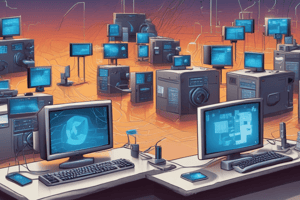Podcast
Questions and Answers
What was the hallmark of the third generation of computers?
What was the hallmark of the third generation of computers?
- Introduction of artificial intelligence
- Development of integrated circuits (correct)
- Linking computers to form networks
- Interaction through keyboards and monitors
What technology did the first computers of the third generation use to store instructions?
What technology did the first computers of the third generation use to store instructions?
- Transistors
- Silicon chips
- Magnetic core technology (correct)
- Magnetic drum
How did the microprocessor advance the fourth generation of computers?
How did the microprocessor advance the fourth generation of computers?
- Linking computers to form networks
- Introduction of the Internet
- Integration of thousands of circuits onto a single chip (correct)
- Development of GUIs
What distinguished the fourth generation of computers from the third generation?
What distinguished the fourth generation of computers from the third generation?
How did third-generation computers differ from second-generation computers in terms of size and cost?
How did third-generation computers differ from second-generation computers in terms of size and cost?
What led to the accessibility of computers to a mass audience for the first time?
What led to the accessibility of computers to a mass audience for the first time?
Which generation of computers is characterized by the development of the Internet?
Which generation of computers is characterized by the development of the Internet?
How did computers in the fourth generation interact with users?
How did computers in the fourth generation interact with users?
What was a significant feature of the fifth generation of computers?
What was a significant feature of the fifth generation of computers?
What technology drastically increased the speed and efficiency of computers in the third generation?
What technology drastically increased the speed and efficiency of computers in the third generation?
Flashcards are hidden until you start studying
Study Notes
Classification of Computers
- Classified on the basis of size, functionality, and data handling
- Classified into supercomputer, mainframe, mini computer, micro computer, and workstation based on size and capacity
Types of Computers
- Supercomputer: one of the fastest computers, very expensive, and employed for specialized applications that require immense mathematical calculations
- Mainframe: very large in size, expensive, and capable of supporting hundreds or thousands of users simultaneously
- Minicomputer: multi-user computer system, capable of supporting hundreds of users simultaneously
- Workstation: single-user computer system, similar to personal computer, but with a more powerful microprocessor
- Personal Computer (PC) or Micro-Computer: single-user computer system, having a moderately powerful microprocessor, and equipped with a microprocessor as its CPU
Generations of Computers
- First Generation (1946 - 1958): used vacuum tubes for circuitry, magnetic drums for memory, and were often enormous, taking up entire rooms
- Second Generation (1959 - 1964): transistors replaced vacuum tubes, allowing computers to become smaller, faster, cheaper, and more reliable
- Third Generation (1965 - 1970): development of integrated circuits, transistors miniaturized and placed on silicon chips, and computers became smaller and cheaper
- Fourth Generation (1971 - Today): microprocessor brought the fourth generation, with thousands of integrated circuits built onto a single silicon chip, and led to the development of the Internet and GUIs
- Fifth Generation (Today to Future): based on Artificial Intelligence (AI) and still in development
Studying That Suits You
Use AI to generate personalized quizzes and flashcards to suit your learning preferences.




